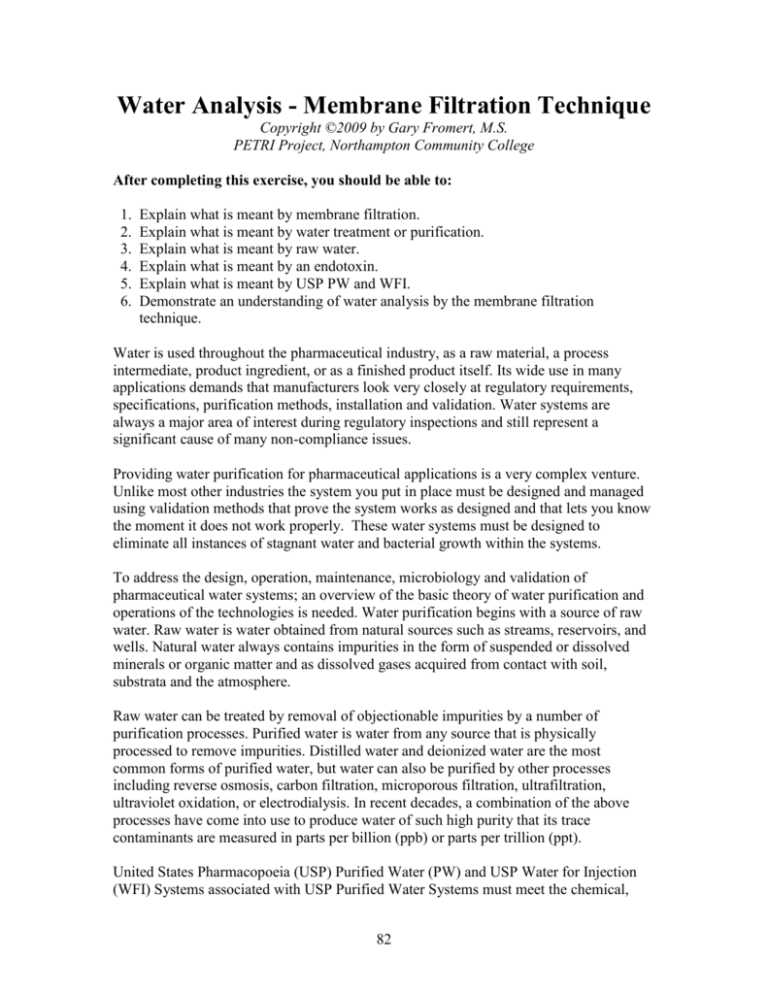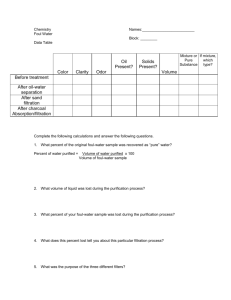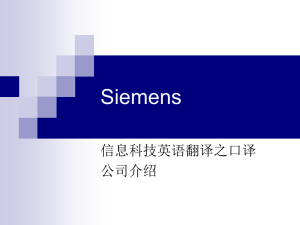Water Analysis MFT - Workforce Solutions
advertisement

Water Analysis - Membrane Filtration Technique Copyright ©2009 by Gary Fromert, M.S. PETRI Project, Northampton Community College After completing this exercise, you should be able to: 1. 2. 3. 4. 5. 6. Explain what is meant by membrane filtration. Explain what is meant by water treatment or purification. Explain what is meant by raw water. Explain what is meant by an endotoxin. Explain what is meant by USP PW and WFI. Demonstrate an understanding of water analysis by the membrane filtration technique. Water is used throughout the pharmaceutical industry, as a raw material, a process intermediate, product ingredient, or as a finished product itself. Its wide use in many applications demands that manufacturers look very closely at regulatory requirements, specifications, purification methods, installation and validation. Water systems are always a major area of interest during regulatory inspections and still represent a significant cause of many non-compliance issues. Providing water purification for pharmaceutical applications is a very complex venture. Unlike most other industries the system you put in place must be designed and managed using validation methods that prove the system works as designed and that lets you know the moment it does not work properly. These water systems must be designed to eliminate all instances of stagnant water and bacterial growth within the systems. To address the design, operation, maintenance, microbiology and validation of pharmaceutical water systems; an overview of the basic theory of water purification and operations of the technologies is needed. Water purification begins with a source of raw water. Raw water is water obtained from natural sources such as streams, reservoirs, and wells. Natural water always contains impurities in the form of suspended or dissolved minerals or organic matter and as dissolved gases acquired from contact with soil, substrata and the atmosphere. Raw water can be treated by removal of objectionable impurities by a number of purification processes. Purified water is water from any source that is physically processed to remove impurities. Distilled water and deionized water are the most common forms of purified water, but water can also be purified by other processes including reverse osmosis, carbon filtration, microporous filtration, ultrafiltration, ultraviolet oxidation, or electrodialysis. In recent decades, a combination of the above processes have come into use to produce water of such high purity that its trace contaminants are measured in parts per billion (ppb) or parts per trillion (ppt). United States Pharmacopoeia (USP) Purified Water (PW) and USP Water for Injection (WFI) Systems associated with USP Purified Water Systems must meet the chemical, 82 bacterial and bacterial endotoxins standards set for USP WFI. Purified Water is described in the USP 23 monograph as follows: "Purified Water is water obtained by distillation, ion-exchange treatment, reverse osmosis, or other suitable process. It is prepared from water complying with the regulations of the U.S. Environmental Protection Agency (EPA) with respect to drinking water. It contains no added substances." Microbial Quality for Purified Water Regarding the bacteriological purity of PW, the monograph (legally enforceable section) states only that PW must comply with the EPA regulations for drinking water. The EPA regulations only specify limits for coliform bacteria. In the informational section of the USP 23, which deals with action guidelines for the microbial control of ingredient water, it says: "A total microbial (aerobic) count that may be used for source drinking water is 500 colony-forming units (cfu) per mL. A general guideline for Purified Water may be 100 cfu/mL." These numbers for cfu/mL are only advisory guidelines that represent recommended alert/action limits, not reject levels. The informational section also suggests that the microbial action limits for PW should be based on the intended use of the water and the nature of the product being made. It recognizes that microbial limits for PW require being defined on a case-by-case basis. The USP 23 monograph states: "Water for Injection (WFI) is water purified by distillation or reverse osmosis (RO)." WFI is produced by either distillation or 2-stage RO. It is usually stored and distributed hot (at 80°C) in order to meet microbial quality requirements. Microbial Quality for Water for Injection The USP monograph makes no references to bacteria limits for WFI. It does not need to be sterile; however, the monograph specifies that WFI not contain more than 0.25 USP endotoxin units (EU) per mL. Endotoxins are a class of pyrogens that are components of the cell wall of Gram-negative bacteria (the most common type of bacteria in water). They are shed during bacterial cell growth and from dead bacteria. Indirectly, the water must be of a very high microbial quality in order to have a low endotoxin concentration. The USP informational section recommends an action limit of 10 cfu/100mL. The recommended method of testing is membrane filtration of a 100-mL sample and plate count agar at an incubation temperature of 30°C to 35°C for a 48-hour period. 83 In this laboratory you will analyze raw water samples and water samples that have been processed through certain purification and sterilization steps that would be representative of a purification process train. Using the membrane filtration technique you will determine the number of viable bacteria by applying the membrane to a nutritive media to allow for the growth and total counts. The nutrient plates contain sterile growth media in which water can indirectly be monitored for viable microorganisms. The plates are typically incubated at 35°C for 48 hours after which the total number of microorganisms will be counted and the results recorded. Materials (per group of students) 6 Nutrient Agar or Trypticase Soy Agar (TSA) Plates 6 Sterile Membrane Filtration Units 0.45m (Note: units must be of the type that have removable membranes) 50 mL Beaker 95% Ethanol China Marker or Sharpie Bunsen Burner Büchner Vacuum Flask and No. 8 stopper with 9/16 in. single-hole opening (Note: the flask and stopper may or may not be used in this lab exercise depending on the design of the filtration unit used) 5 Water Samples of Various Purity and Sterility 100mL each (Examples: 1. Sterilized water, 2. Nonsterilized DI water, 3. Chlorinated tap water, 4. Nonchlorinated tap (well) water, 5. Pond, lake or stream water) Procedure Water analysis for total viable bacteria Note: You will be instructed as to the samples that your group will analyze as well as to the setup and use of the membrane filtration unit or apparatus. Membrane Filtration Technique Note: Maintain aseptic technique throughout the laboratory exercise! Acquire the water samples that your group will be processing and analyzing. 1. Mark the bottom of one of the nutrient agar plates "Control", include your initials and the date, and then set aside. 2. Mark the bottom of the remaining nutrient agar plates that will identify the water samples that you are given; include your initials and the date on each plate. 84 3. Remove the wrapping from the all the membrane filtration units according to the instructions on the wrapper. 4. Mark the lid or side of one of the membrane filtration units "Control". 5. Mark the lid or side of the remaining membrane filtration units that will identify the water samples that you are given. 6. Place approximately 15mL to 20mL of ethanol into the 50mL beaker. Place the open end of the forceps into the beaker containing the ethanol. Immediately flame the forceps, allowing the ethanol to catch flame and immediately remove from the flame of the Bunsen burner. Allow the ethanol flame to extinguish. The forceps is now considered "flame sterilized". Note: Be sure to hold the forceps in a slightly downward position once removed from the beaker and during flaming as to not let the ethanol run down the forceps on to your hand! 7. With your free hand or one of the group members, break the seal of the membrane filtration unit labeled "Control" between the funnel portion and the base of the filtration unit exposing and allowing access to the membrane. 8. Aseptically, remove the membrane from the base by grasping the edge of the membrane with the forceps. 9. Aseptically, transfer the membrane to the nutrient plate by applying the membrane to the surface of the media using a rolling motion. Note: If membranes are gridded, apply grid-side up. If not, apply funnel-side up. 10. Set aside as this is the control. 11. Place the forceps in the beaker of ethanol. 12. Pour each of the water samples into their respectively marked filter units funnel up to the 100mL mark on the funnel. 13. Depending on your specific type of filter unit, either apply a vacuum to the vacuum port on the unit or place the filter unit assembly on to the Büchner vacuum flask assembly and apply a vacuum. Apply the vacuum until all of the water has passed through the membrane. 14. Flame sterilize the forceps and proceed to aseptically transfer the processed membranes to their respective nutrient plate using the technique described for the control membrane. Note: Be sure to flame sterilize the forceps between each transfer! 15. Invert the plates (lid side down), and incubate the plates at 35°C for 48 hours. 16. Observe all the plates for colonies of viable bacteria that have grown on the surface of the membranes. Count the colonies and record. 85 Results and Observations After examining your plates, count the colonies and record your results in the following table. For all plates, quantify your results as follows: No growth 1 to 200 colonies > 200 colonies 0 Record the actual colony counts TNTC (Too numerous to count) Membrane Filtration Technique Sample Sample Name Total Viable Bacterial Count (CFU/100mL) Control 1 2 3 4 5 Laboratory Review 1. Explain what is meant by membrane filtration. ________________________________________________________________________ ________________________________________________________________________ ________________________________________________________________________ ________________________________________________________________________ 2. Explain what is meant by water treatment or purification. ________________________________________________________________________ ________________________________________________________________________ ________________________________________________________________________ ________________________________________________________________________ 3. Explain what is meant by raw water. ________________________________________________________________________ ________________________________________________________________________ ________________________________________________________________________ ________________________________________________________________________ 4. What is the purpose of monitoring USP PW and WFI for viable microorganisms? ________________________________________________________________________ ________________________________________________________________________ ________________________________________________________________________ ________________________________________________________________________ ________________________________________________________________________ ________________________________________________________________________ 86 5. What is an endotoxin and why is the membrane filtration technique in monitoring bacteria important in regard to endotoxin concentrations? ________________________________________________________________________ ________________________________________________________________________ ________________________________________________________________________ ________________________________________________________________________ ________________________________________________________________________ ________________________________________________________________________ 6. Speculate as to the limitations the membrane filtration technique may have in monitoring bacterial levels in liquids. Hint: Turbidity. ________________________________________________________________________ ________________________________________________________________________ ________________________________________________________________________ ________________________________________________________________________ ________________________________________________________________________ 7. Speculate as to why a pore size of 0.45m for the membranes is used for bacterial analysis of liquids. ________________________________________________________________________ ________________________________________________________________________ ________________________________________________________________________ ________________________________________________________________________ ________________________________________________________________________ 87







